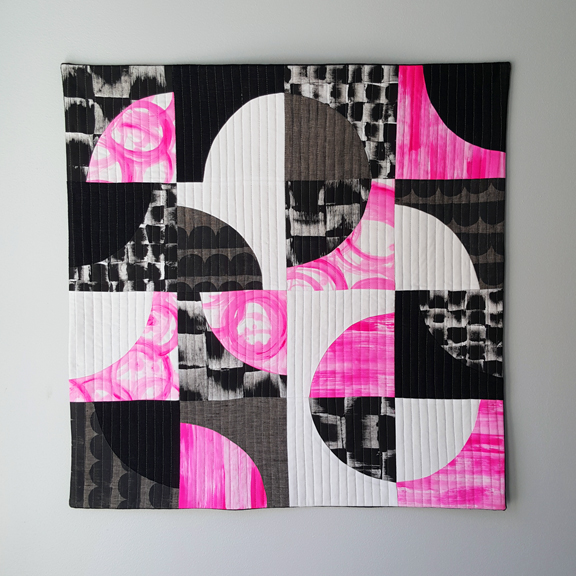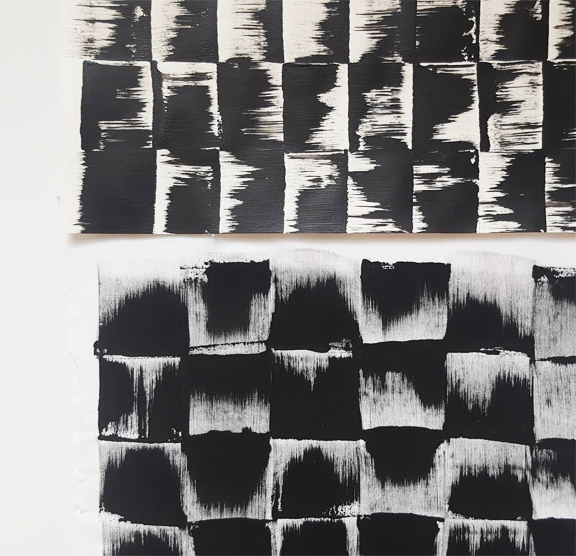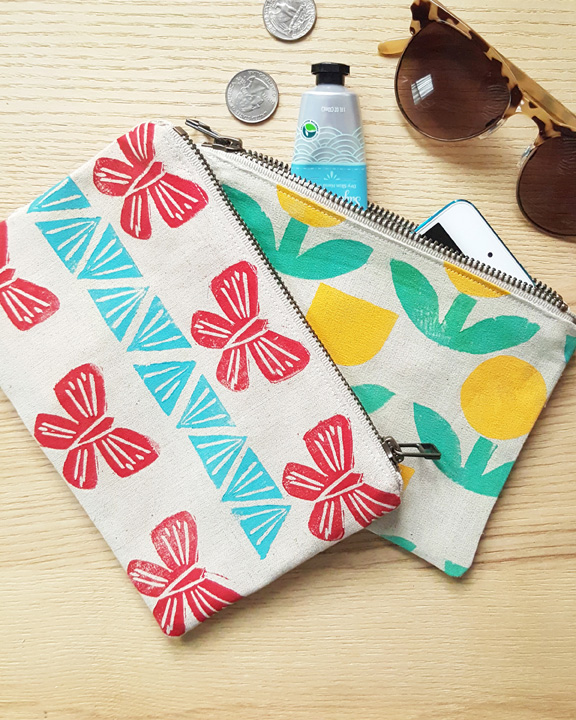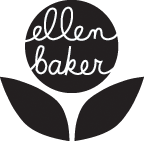
Are you excited about fall? I am, but also feeling the stress of our busy schedule that blows in with this crisp air. I’m working on a few things right now. First, I’m still compiling my spring collection for Kokka, which is influenced by hand printed designs, so I’m enjoying getting messy with paint.
I’ve also been painting fabric and making small quilts like the 24″ x 24″ piece shown above. The fabric for this piece came from my experiments like the one below, painted with a foam brush on both paper and fabric. I find that when I’m not feeling creative, I just force myself to try new things.

From Bed to Wall: Elevating the Quilt from Necessity to Art
After the Modern Quilt Guild issue over derivative work, I’ve been thinking about where we get our inspiration, which led me to reflect on the history of modern quilts. The style that we refer to as “modern” has been heavily influenced by the quilts of Gee’s Bend. As the art world discovered these quilts and “elevated” them from rural Alabama beds to the pristine white walls of art institutions in major cities, the patchwork quilts created to keep children warm in the winter were suddenly ordained as art. This pocket of creativity seemed to be created in a vacuum, apart from the established art world, much to the astonishment of critics with their proprietary sense of aesthetics.
Even though I grew up in Alabama less than two hours away from Gee’s Bend and had heard of the quilters, I didn’t see these powerful quilts in person until 2006 at the High Museum of Art here in Atlanta. Now as I think about making quilts that emphasize form over function, I consider the influence these quilts have on the modern quilting lexicon. Where do we draw the line between inspiration and cultural appropriation? When we look at the history of Gee’s Bend, there is no doubt that slavery, racism, and Jim Crow-era cultural isolation influenced the design and necessity of these quilts. Because Gee’s Bend is nestled in an oxbow of the Alabama River, residents used a ferry when traveling to nearby Camden to register to vote, so the ferry service was cut off in 1962. “We didn’t close the ferry because they were black,” The sheriff reportedly said at the time. “We closed it because they forgot they were black.”
How can we be inspired by this work without, perhaps unintentionally, co-opting its history of oppression? As modern quilters, we borrow from both the European-American history of patterned quilts, yet even more from the improvised, colorful, and graphic quilts of Gee’s Bend. How can we juxtapose these influences with their history of conflict? It’s something to consider; as we move forward, we should always remember the past.
When we make a vertical shift and remove the utilitarian function of a quilt by hanging it on a wall, we acknowledge the distinction between art and craft. While I love many quilts that I see in the world, I’m struggling to find my own style. This style will no doubt be derivative, in the most positive sense, influenced by others who made quilts before me. As we make quilts for art or leisure, we can’t forget the women who made them out of necessity for comfort and warmth. The women of Gee’s Bend made quilts with old clothing, scraps of fabric, and whatever they could find to keep warm. When we elevate quilts to the wall, we suddenly declare their significance outside of the domestic realm. By simply choosing quilting as an artistic medium, we invite the complexities of identity, aesthetics, and necessity into our stitches. It’s all derivative, but we’re all different.
Here’s some encouragement to find your own creativity:
In the quilting bee time, I started using patterns, but I shouldn’t have did it. It broke the ideas I had in my head. I should have stayed with my own ideas. –Gee’s Bend quilter Nettie Young
October Tutorial: Printed Pouch

Make your fabric experiments functional. Here’s a quick tutorial for a basic lined, zippered pouch. This is a sewing staple and with just a few simple materials, you can stamp your own fabric.
Links:
Read the amazing stories of the Gee’s Bend quilters.
This article from author Michael Chabon is beautiful. If you have a unique and creative child, read on because that last paragraph will get you. My Son, The Prince of Fashion.
Watch this inspirational video about The Art of Japanese Marquetry.
Check out this amazing “lace” street art by Polish artist NeSpoon.
Fall is here, so sew up some cozy pajama pants or a soft quilt with these cat and mouse flannel fabrics from my Parallels collection. Available here.

